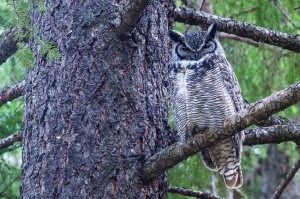
Last week I had a staring contest with a great horned owl, and I can assure you, I blinked first. There is nothing quite like having one of these raptors peer down at you from a tree bow, its eyes unflinching while massive talons grip tightly to the branch. Did I mention talons? You know, the ones that can tear apart a snowshoe hare as easily as plucking a flicker from the sky?
A flicker, which is part of the woodpecker family, was probably a recent meal of this owl and its family, as evidenced by the red-shafted brown feathers caught in the thicket of the owl nest nearby. This is what Mark Bradley, a Jasper National Park wildlife biologist, thinks happened, and he’s a much better birder than I. He said great horned owls eat all sorts of things. Mice, grouse, fish, squirrels, voles, grebes, and geese, to name a few.
“In the past, there was a nest at Jasper Park Lodge with duck and coot feet littered on the ground below it,” he said, adding that great horns will even eat other owls if they can catch them.
On this trip, we were not at Jasper Park Lodge, but instead at the not-so-secret nest of great horns at Lake Edith. Bradley pointed out white winged scoters and blue winged-teals in the distance, paddling around looking for food to re-charge them for the remainder of their trip north. On the edge of the lake, constructed from a mess of witch’s broom in a spruce tree, is our owl nest. In it was a fuzzy, rotund owlet with downy white feathers.
This owlet is probably very close to living life on its own. In general, eggs are laid in February, and incubated for 30-40 days. Once born, the young nest for another 40-50 days, and around here are independent by mid to late May.
“This guy will be a brancher soon,” said Bradley, explaining that to prepare to learn to fly owlets will start walking around the tree, working up the grit and motor skills to lift off.
Owls are strong fliers, but not as fast as other raptors like hawks. However, it’s all about trade-offs. Hawks are more visible to their prey while hunting during the day, and have wings that produce a loud whooshing sound on approach. They compensate for this by travelling at speeds too fast for prey to be warned. In comparison, owls hunt under the cover of darkness, and make no sound at all. The front edge of their wings are fringed with a comb, the tines of which break up the wind flowing over the wing. The downy feathers that follow also dampen the sound, and the jagged tail feathers to the back of the wing finish the job. It’s no surprise their wings have been studied by aeronautic engineers interested in stealth flight.
It’s not just the wings that are adapted for night hunting. The eyes of the great horned owl are loaded with cells adapted for night vision, and are more like telephoto lenses than balls, said Bradley. This gives them exceptional binocular vision for hunting, but poor peripheral vision, which is why they have evolved to be able to turn their heads up to 180 degrees.
Though their vision is super-adapted for their hunting style, they also rely heavily on sound. Like a satellite dish, their faces funnel sound waves into their ears, picking up the slightest pitter-patter of tiny vole feet, even under the snow. They can adjust the shape of the disk with their face muscles to change the acuity of the sound. Their ears, located to the side of their eyes, are even slightly asymmetrical on their heads so that they can zero in on the sound created by one prey, rather than catch sounds coming in from different angles, explained Bradley.
Back at Lake Edith, a gentle “hoo hoo hoo, hoo hoo hoo” draws our attention to another tree. There’s the adult female of the pair – at least we think so. “Females are larger than males,” said Bradley. But it’s hard for us to tell when they’re not side-by-side. I peer up at her for a while, and lose another staring contest. I feel like confessing something to this bird, I’m just not sure what.
The female lets loose a series of squawk-like sounds. “She wants us to go,” said Bradley. “You should never spend too long at any nest, because it stresses the birds.” No argument here. I steal another glance at the now sleeping, fuzzy white owlet, and then head out along the path under the laser-like gaze of its parents.
Niki Wilson special to the 51����
